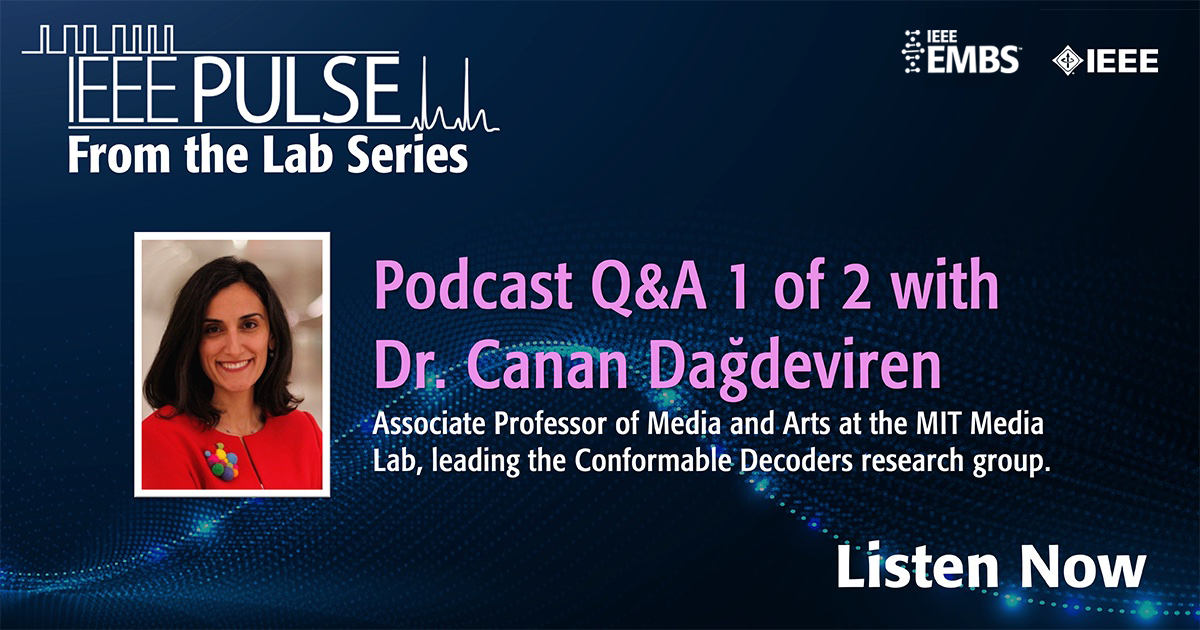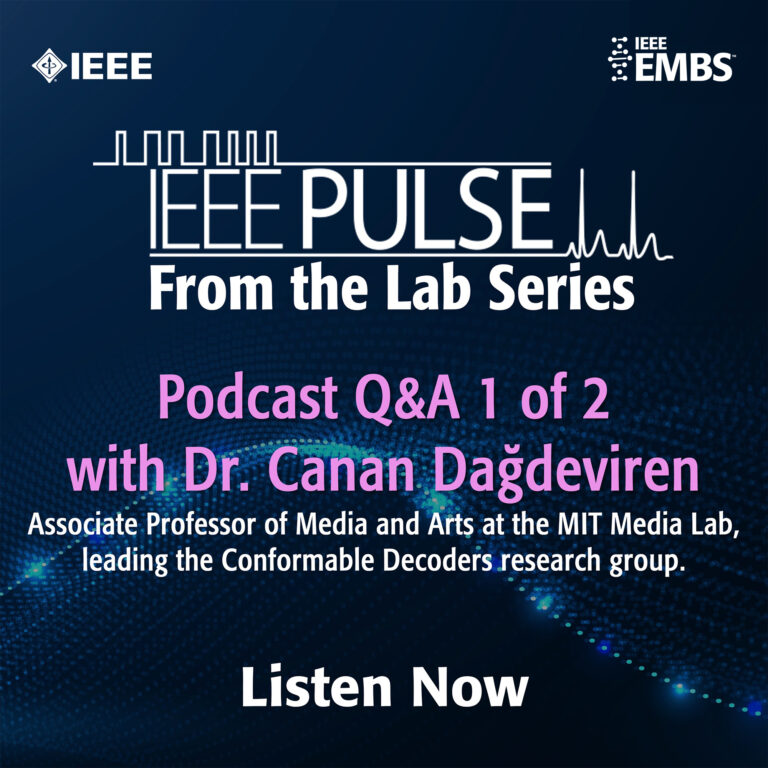
IEEE Pulse: From the Lab podcast episode in partnership with the IEEE Open Journal of Engineering in Medicine and Biology (OJEMB), featuring Dr. Canan Dagdeviren — physicist, material scientist, Associate Professor of Media and Arts at the MIT Media Lab, and leader of the conformable decoders research group. Dr. Dagdeviren shares insights on her research, which aims to convert the patterns of nature and the human body into beneficial signals and energy. This episode is Part 1 of 2.
Transcript
Episode 1 featuring Canan Dagdeviren, Associate Professor of Media and Arts at the MIT Media Lab, Part 1
Welcome to the IEEE Pulse “From the Lab” podcast series. This episode is a digital production in partnership with the IEEE OJEMB, The Open Journal of Engineering in Medicine and Biology, which serves the global community of innovators spanning medicine, technology and science today. In this first in a series of interviews, Vivian Kelly, founder and CEO of Interprose, is joined by Canan Dagdeviren.
Originally from Istanbul, Turkey, Canan is a physicist, material scientist and assistant professor of media and arts at the Massachusetts Institute of Technology (MIT), where she leads the conformable decoders research group, which aims to convert the patterns of nature and the human body into beneficial signals and energy. Canan’s work has been featured in numerous media outlets and she has been a guest editor of a special issue of the IEEE OJEMB, focused on conformable decoding. Canan shares insights of her research and the conformable decoders group at the MIT Media Lab where they are working to create mechanically adaptive electromechanical systems that can integrate with the target object of sensing actuation and energy harvesting among other applications.
IEEE Pulse: Thank you for taking the time to share your insights with the audience today. Can you provide a little more information on your education and background?
Canan Dagdeviren: My name is Canan Dagdeviren and I came to the U.S. in 2002, and in 2009 was a Fulbright Scholar. I started my Ph.D. degree at the University of Illinois, Urbana-Champaign where I learned about how to make flexible and stretchable devices. Back in Turkey, all the devices that I was trying to do were bulky and not suitable for biomedical applications.
I found my amazing adviser, John Rogers, and with my scholarship, I was successful in enrolling in the university and started working with him. After my PhD degree, I became a postdoctoral associate at MIT’s Koch Institute for Cancer Research and started working with the legendary Bob Langer on implantable devices — this time from wearable to implantables. In the same year, 2014, I was nominated for a Harvard Junior Fellowship by my PhD advisor, and I became a Junior Fellow in the Society of Fellows at Harvard University. Around two and a half years later, I got a job offer from MIT, and became an assistant professor in 2017. I recently became an associate professor and just earned my promotion.
IEEE Pulse: Congratulations. That’s quite an illustrious career. That’s a great background you have behind you. Where is that?
Canan Dagdeviren: This is my cleanroom. You can actually see the lab is made entirely of glass walls so you can see whatever we do inside the cleanroom. Maybe I can little bit describe what cleanroom means. A cleanroom is a special lab, as you can guess from the name, but I call this lab a “yellow box.” It’s a yellow color and it’s like a box shape. It’s yellow because we use UV sensitive polymers to make our devices and we tint the glass so that it looks like yellow, but inside is perfectly white when we are in the rooms. It’s clean because the feature size of our devices is so tiny and we don’t want any dust particles to be a part of it. So up there in the ceiling, we have HEPA filters, which suck the entire dust from the environment, leaving a clean atmosphere for us, and we wear this kind of funny suit and go inside the cleanroom to work on our devices.
This was actually my dream. When I was at the University of Illinois, I was one of the few female scientists in the group. And back to Turkey, I really had great theoretical knowledge but no practical knowledge at all. I didn’t know how to handle a wafer, how to spin code, how to mix the materials. It was all about the books, book reading and the knowledge through the books. So, whenever I had a question or requested help people were too busy and I was rarely getting an answer. So instead of being sad and going back to my home country, I took a chair and sat on it, observed everyone from morning till night for months and years. And finally, I found a working recipe and afterwards, everything started working perfectly well.
Then I made a promise to myself, and I said in the future if I have a chance to build my own lab, I’ll make it physically transparent, so that people can see through to whatever we do inside the cleanroom without taking any permissions and training. And guess what, this is now the case in the corner of the corridor, and on any single given day, you can see students are sitting in the corner and watching us or even sometimes, like little students — primary students, high school students — that are coming in and watching what we do. It’s also a way to inspire the young generation about the things that we do and show that it is not impossible. Everybody can do it as long as they have enough dedication and resources as we do have at MIT.
IEEE Pulse: This is such an exciting field, and hearing you talk about inspiring young people is important. What inspired you to get into this field or science at all, and how young were you when you decided this was your dream job?
Canan Dagdeviren: So, this story that was told to me by my parents, I don’t remember it, but I was smashing a box trying to find the atoms inside and everybody was telling me that it was an impossible task. But I was like still trying to understand where the atoms were. I think I heard from somewhere either from television or a book, or from my parents, but this sort of confirmed my passion for science. And my father gifted me a book about Madame Curie. I think he thought I would have inspiration from her. But when I read the book, I fell in love with her husband, Pierre Curie, who discovered piezoelectricity. It’s an amazing phenomenon. Like when you smash up rocks, you can see the spark and to me, it was extremely magical. And I was sort of interested in that.
But then, of course, I didn’t know what to do. I was very young. I was very much into chemistry, biology, medicine, and physics, but I was not sure what to do. Then, during a moment at a book exhibition, I met one of the prominent scientists, a theoretical physicist, and also the prime minister of Turkey at the time. His name is Erdal İnönü, and he gave me his book and said, why don’t you read this? Maybe this book will really inspire you. So, I read the book and I thought, yes, I’m very much into science and specifically physics. And I went on to study solid state physics. I went to Ankara, the capital city of Turkey, and had my education in physics.
Overall, I would say the tone of my research is also very much personal, because when I was young, I learned that my grandfather passed away at the age of 28 because of heart failure. I never got to meet him, and I made a promise when I reached the same age of 28, when my grandfather passed away, until a late age, I really would like to do something for heart patients. And, of course, working for years, and with amazing people and advisors and mentors, when I reached the age of 28, I achieved my promise and successfully completed a device which can be used by heart patients. It’s a flexible device that can be used on beating organs like heart, lungs, and diaphragm. And whenever your heart beats or you inhale and exhale, this device can be deformed and the piezoelectric components that are on site on top of it — the magical things that I was inspired by Pierre Curie — can generate a spark voltage and current and it can be used to charge your pacemaker without the requirement of replacing the battery.
When I was 28, it was completed and patented. I also received the Illinois Innovation Prize and was named on the list of Forbes “30 under 30, “and in MIT Technology Review “35 under 35.”
IEEE Pulse: So, your research is in conformable decoders?
Canan Dagdeviren: Yes exactly. The name is conformable decoders. So, what we think as a whole group is that we live in an ocean of physical patterns, heart rates, respiration, neuronal activity, temperature changes, and so on. And these biological patterns, what I call biological language, contain information in coded ways.
So, we need to decode these messages in biological language into electrical language if we want to create a better interface between patients, individuals, and medical doctors.
That’s why we create decoders which can decode these physical patterns, and these sophisticated devices are conformable. What I mean by that is that they can take the shape of any targeted human organ or part. For instance, if you want to go inside the deep brain to understand the neurological changes, then these devices are three-dimensional, and they can go inside of the brain and do multiple things at a time. Or if we would like to understand the changes on skin, then the device is two dimensional, mostly large area, with very thin structure as thin as your hair fiber and the modulus value — the softness of it — can match with your skin so that it could conform. It can have its shape, even the wrinkles. It can take the shape of the wrinkles and have an intimate integration with this body part so that we can really decode all the patterns in a meaningful way, and we can understand what our biological language is exactly telling us. This is why the name of my group is conformable decoders.
IEEE Pulse: Thank you for listening to this first in a series of interviews with Canan Dagdeviren. To learn more about IEEE Pulse please visit our website at www.embs.org/pulse/. This conversation continues in Episode 2 of IEEE Pulse: From the Lab.
Please note that this transcript has been slightly modified from the oral conversation for readability purposes.



